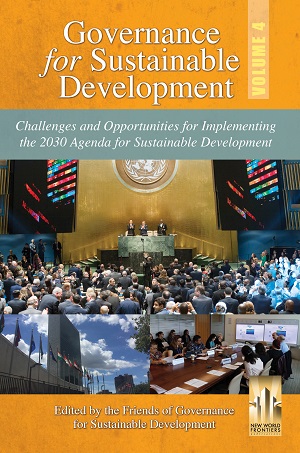
A sneak peek at key points from my chapter in a new book in governance and the link to Agenda 2030 from the UN’s Friends of Governance for Sustainable Development expert advisory group (including UN diplomats and senior academics). The full text is here for download or via Amazon here. The ‘friends of’ group aims to promote good governance (effective, transparent, accountable and democratic institutions) as an underpinning of sustainable development. Founded in 2010, its work is coordinated by the governments of Germany, Morocco, Nigeria, Republic of Korea and Romania.
Why apply strategic foresight to planning for the SDGs?
- One-third of the way to the Sustainable Development Goals (SDGs) deadline, questions are rightly being asked about the achievability and credibility of the SDGs. With multilateralism under fire, being on the front foot in anticipating and preparing for future challenges is more important than ever – not just to UN programmes and policies, but to the UN’s legitimacy and integrity, and its prospects in 2045 and beyond.
- The world of 2030 will, without question, be radically different to the world of 2015. The level of global volatility and the unprecedented pace of change demand an energised, stepped-up response to meeting the SDGs. We cannot predict the 2030 world with any certainty – but we can engage constructively with it through foresight techniques that allow us to consider alternative futures (scenarios).
- Strategic foresight (systematically exploring future issues and their impacts) helps us see not just a clearer path towards a (realistic) vision for 2030, but also how to get there in spite of uncertainty – by anticipating and adapting.
Top tips on applying foresight to achieving the SDGs and to foresight for development more broadly:
- The world can be divided into pessimists and optimists, but futurists need to be both. Be rigorous in considering both the upsides and downsides (threats and opportunities) of future trends.
- Be sceptical of linear beliefs about the future (projections based on past data, or dominant ‘official’ narratives about probable futures held dear within institutions). So often through history, the impact of new trends has been critically under- or over-estimated, with real implications for the response.
- Look beyond the obvious technological developments or innovations that might impact on delivery of specific SDG indicators to explore slow-moving but inexorable, often cumulative megatrends.
- Use horizon-scanning tools to ensure that ‘weaker signals’ are picked up, offering valuable early warning on slow-burning issues typically neglected by short-termist policymaking. Note, too, that not all key issues will be ‘new’ or ‘emerging’ – as futurist Jim Dator observes, the future is full of (i) existing trends that change; (ii) historic trends that re-emerge; and (iii) novelties.
- Make foresight capabilities and a foresight culture mainstream within the UN institutions, particularly:
- As a core competency for Regional Coordinators and in Country Teams;
- By championing existing work such as UNESCO’s network of foresight chairs and work on futures literacy;
- By giving clear public signals that the UN is thinking about global futures – such as a major UN conference on the 2030 future and using the UN75 dialogue to start a conversation about UN100.
If you work in the development field, take a look at our free resources here to support you in using foresight in your work – including our new futures toolkit for Save the Children UK and the SOIF Primer on key futures tools.
